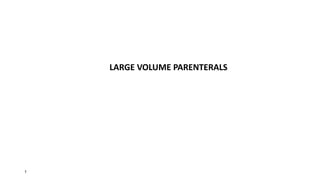
LVP.pptx
- 2. The USP provides the definition for large volume parenterals (LVP’s) the Large Volume solution applies to an injection that is intended for intravenous use and is packaged in containers holding 100 ml or more. LVP’s” means a sterilized aqueous drug products packaged in a single dose container with a capacity of 100ml or more.
- 3. 3 Packaged in glass bottles or in large volume flexible containers. ➢ May contain greater than 100 mL to greater than 1 or 2 L ➢ Sterile (e.g., many LVP are sterilized in their container via heat, although some are sterile-filled) ➢ Pyrogen-Free ➢ Essentially free of particulate matter ➢ No anti-microbial agents ➢ Isotonicity ➢ Longer term use Characteristics of LVP
- 4. Because of the large volumes administered, these solutions must not contain bacteriostatic agents. These are packaged in single dose. Large volume parenterals solutions are employed in maintenance therapy for the patient entering or recovering surgery and for the patients who are unconscious and unable to take fluids, electrolytes and nutrition orally. LVPs may also be used in replacement therapy for patients who have suffered a heavy loss of fluids and electrolytes.
- 5. 5 TYPES OF LARGE VOLUME PARENTERALS Hyper alimentation solutions Cardiolpagic Solutions Peritonial Dialysis solution Irrigating solutions
- 6. 6 HYPERALIMENTATION SOLUTION: Admin. of large amount of nutrients to patients who unable to take food orally. Formulation: mix. of dextrose, amino acids , lipids, electrolytes, & vitamines. TOTAL PARENTERAL NUTRITION Def. :A method of feeding patients by infusing a mixture of all necessary nutrients into the circulatory system, thus bypassing the GIT.
- 7. 7 CARDIOLPLEGIC SOLUTIONS LVP are used in heart surgery to prevent injury to myocardium during reperfusion, as well as to maintain bloodless operating field. Maintains the diastolic arrest. Administered in cold form. Slightly alkaline to compensate metabolic acidosis, Hypertonic USE: To minimize reperfusion injury resulting from tissue edema.
- 8. 8 PERITONEAL DIALYSIS SOLUTION Infused continuously into abdominal cavity, bathing peritonium & are then continuously withdrawn. USES : Removal of toxic substances from body. To aid & accelerate excretion normal. To treat acute renal insufficiency
- 9. 9 IRRIGATING SOLUTIONS To irrigate ,flush, & aid in cleaning body activities & wounds. Certain IV solution ( normal saline ) may be used as irrigating solution, but solution designed as irrigating solution should not be used parenterally. USE: Treatment of serious wounds infused in to blood stream.
- 10. Total Parenteral Nutrition TPN stands for Total Parenteral Nutrition. This is a complete form of nutrition, containing protein, sugar, fat and added vitamins and minerals as needed for each individual. Total Parenteral Nutrition (TPN) may be defined as provision of nutrition for metabolic requirements and growth through the parenteral route.
- 11. •Components of TPN solutions: (1) Protein as crystalline amino acids. (2) Fats as lipids. (3) Carbohydrate as glucose. (4) Electrolytes–Sodium, potassium, chloride, calcium and magnesium. (5) Metals/Trace elements–Zinc, copper, manganese, chromium, selenium. (6) Vitamins A, C, D, E, K, thiamine, riboflavin, niacin, pantothenic acid, pyridoxine, biotin, choline and folic acid. http://pharmacy2011foru.blogspot.com/
- 12. • TPN is normally used following surgery, when feeding by mouth or using the gut is not possible, • When a person's digestive system cannot absorb nutrients due to chronic disease, or, alternatively, if a person's nutrient requirement cannot be met by enteral feeding (tube feeding) and supplementation.
- 13. IV Admixtures • Definition: • When two or more sterile products are added to an IV fluid for their administration, the resulting combination is known as IV admixture. • In hospitals, prepared by nurses by combining or mixing drugs to the transfusion fluids. • The drugs are incorporated in to bottles of LV transfusion fluids.
- 14. 14
- 15. CHARACTERISTICS OF LVPs • Packaged in glass bottles or in large volume flexible containers. • May contain greater than 100 ml to greater than 1 or 2 L • Sterile • Pyrogen-Free • Essentially free of particulate matter • Isotonicity
- 16. FORMULATION Water for injection: WFI is the water purified by Distillation Or Reverse Osmosis. Inorganic Salts Carbohydrates Nitrogen containing substances Tonicity Modifiers
- 17. CONTAINERS AND CLOSURES: Glass containers Glass containers have been employed for LVP’s. Solid rubber stoppers are used for the container closure system. Because of weight and fragility ,the glass containers have been largely replaced by plastic. Glass is used only for sol’ns which are basically incompatible with plastic (e.g. lipid emulsions which may extract plasticizers). Washed,cleaned glass containers should be held at a minimum of 70oC to suppress microbial growth.
- 18. Types of Glass: Type I: Commonly known as neutral glass. It has a high resistance to hydrolysis and withstands autoclaving, weathering and solution of pH of up to 8. Type II : Containers may be treated with moist sulphur dioxide at high temperature to create a neutral surface film with high hydrolytic resistance. Lower resistance to autoclaving than for type I glass. Type III : This offers very little resistance to hydrolysis and should only be used for powders for reconstitution prior to injection and for non aqueous preparations.
- 19. REFERENCES • Pharmaceutical dosage forms: parenteral medications volume 1 and volume 2 by Kenneth E. Avis, Herbert A. Lieberman and Leon Lachman. • Leo. F. blow/ fill/ seal aseptic technology. • USP chapter 797: Establishing a practice standard for compounding sterile preparations in pharmacy. • SCHEDULE M
- 20. THANK YOU
